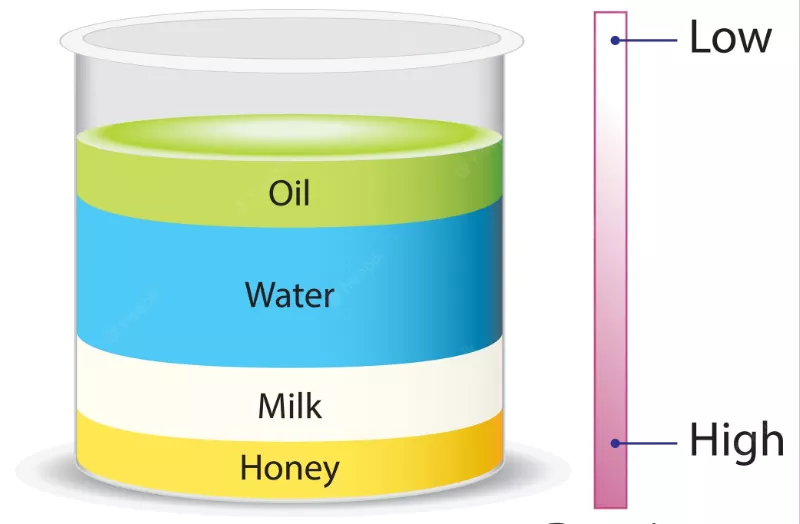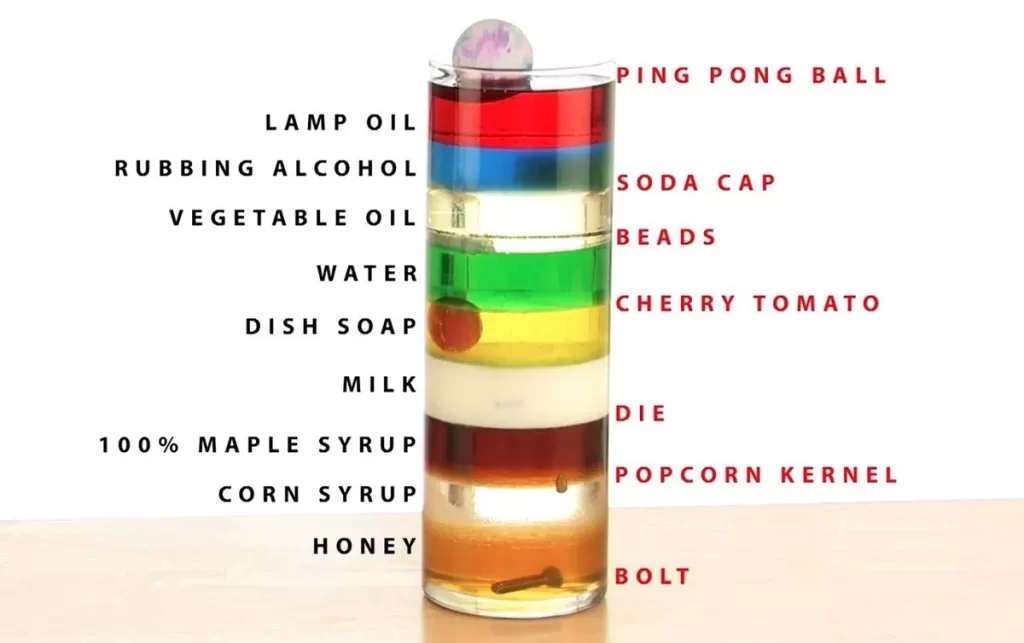Honey is a product that has been loved and respected since ancient times, its unique medicinal and nutritional properties have not lost their importance to this day, but it has a number of properties that determine its quality. And the density of honey takes the leading position among these properties. Continue reading this article to find out what’s the density of honey, how it is determined, what affects honey density, density of honey in g/ml, density of honey in g/cm3, etc.

What Is The Density Of Honey Kg/L?
The density of any substance is the ratio of mass to the volume occupied by the mass. Otherwise, this parameter is called specific gravity. This concept is fully applicable to honey as well, moreover, according to density of honey, we can also determine its quality.
When using a parameter, you have to keep in mind that it does not have a uniquely defined value. The density of honey ranges from 1.5-1.4 kg/l. Different sources may express specific gravity in other units-grams per liter, grams per cubic cm, per milliliter. If the density is below the standard, the product is diluted, which means that various additives have been mixed with it. Those can be sugar, flour, starch, semolina.
Variations in honey density are related to the moisture content of the product.
Important! Quality honey at a temperature of 20 ° C contains from 15 to 21% water, which corresponds to the upper value of its specific gravity.
This article will provide you the honey density in kg/m³ (SI unit), g/cm³, g/ml, kg/l, lb/ft³.
Table: Density and viscosity of other substances compared to honey
| Substances | Density (kg/m³) | Viscosity (m/Pa*s) |
| Air | 1.23 | 0.0171 |
| Water | 1000 | 1.002 |
| Blood | 1060 | 2.084 |
| Corn Oil | 1370 | 65 |
| Honey | 1420 | 10,000 |
| Mud | 1730 | 200 |
The amount of moisture in natural honey is determined by several important factors:
- Time. If the bees collect the sweet nectar in wet weather, the moisture in the final product will be higher.
- Degree of maturity. In the early stage, while the bees are still pumping water out of the honey and while processing it, the specific gravity of bee honey will be lower. Vitamins B1, B2, B3, B6 and trace elements magnesium, potassium, iron, all of which honey is known for, are contained only in honey with a density of 1.409-1.510 kg/l.
- Storage conditions. An open container contributes to a change in the density of the honey and even the mass. The humidity of the room air directly affects the density due to the hygroscopicity of the product. When the concentration of water vapor is over 66%, honey absorbs moisture, and below 58& it evaporates. In addition, the storage temperature and the inherent moisture content of honey directly affect the density. For example, sweetness containing 20% moisture has a specific gravity of 1.415g/cm ³ at 15 °C, and 1.403g/cm³ at 20°C.
There are other factors that affect the density of honey-the time of collecting nectar, general climatic conditions, and chemical composition of honey.
According to the last criterion, the density of honey is divided into 5 groups which depends on the type of plant from which the bees collected nectar or honeydew:
- Very liquid-if the nectar is from acacia, clover, sunflower;
- Liquid-melilot, rapeseed, chestnut, buckwheat;
- Dense-dandelion;
- Sticky-honeydew (collected from sweet secretions on the leaves of plants left by insects or from the buds of deciduous or coniferous trees);
- Jellylike –heather.
Note! Honey density is the most important quality parameter in many countries. For example, in Australia the lower threshold must not be less than 1.45g/ml, in Canada -1.47g/ml, in Russia -1.41g/ml.
| Moisture content in % | Specific gravity in g / ml |
| 15 | 1.449 |
| 16 | 1.443 |
| 17 | 1.436 |
| 18 | 1.429 |
| 18.5 | 1.426 |
| 19 | 1.422 |
| 20 | 1.415 |
| 21 | 1.409 |
Does The Density Of Honey Speak About Its Quality?
Real honey is quite thick and if you turn the honey jar upside down, it slowly leaks to the other side of the jar. If the honey quickly moves to the other side of the jar and separates from its bottom, it is probably not the real honey.
The density of the honey must be equalized and the top of the honey should not be runny, and if it is, it is a sign that there is too much water in it and that it is not yet ripe and ready for use. When taking honey with a spoon, it must flow in a continuous thread, not in drops like water.
An important property of honey is crystallization. If you think it’s an indicator of honey gone bad, you are completely wrong. Real honey crystallizes over time. If the honey always remains in a liquid state and foam forms at higher temperatures, it is artificial honey.
You can test the density of honey by placing a spoon in the container of honey and start swirling it. As you remove the spoon from the container, small spirals should form around the spoon, this shows that the honey is clean.
Therefore, honey with a moisture content of 15-17% will be considered high quality. The main moisture content of honey for mass sale is generally 18-19%. If the moisture in honey is 20-21%, that honey will be considered poor quality honey. Moisture in honey can be measured very simply. There is a device called a refractometer and it is used to determine the amount of water in a product. The less water there is, the higher the quality of the product and the longer it can be stored.
Read the article: Forest Honey: Benefits, Properties, Taste, How It’s Produced?
The optimal level of moisture in honey is 16-18.5%. A higher level of moisture favors fermentation, and a lower level favors crystallization of honey. This device is affordable at a good price of only a few dollars and easy to use, you don’t have to worry about the humidity of the honey you took out of the hive or bought in the market. You simply take a drop of honey and put it on the surface of the device and turn the device towards the light and read the result.
What Is The Density Of Honey In g/ml?
Pure honey has a density of 1.36 g/mL.
What Is The Density Of Honey In g/cm3?
Density indicates how tightly packed a substance is and can be measured in terms of mass per unit volume. For example, water has a density of about 1 g/cm3 and density of honey in g/cm3 is 1.44 g/cm3. So honey is denser and you can fit more honey in a smaller space than water.

How much does 1 kg of honey weigh? How Much Honey Is In A Teaspoon And A Spoon?
Honey is used for various purposes in cooking, cosmetology, and healing. So you will most likely see that in some recipe it is mentioned, for example 2 teaspoons or spoons of honey, or say 1 glass of honey, or the quantity in grams is mentioned. This usually cause difficulties with how to measure e.g.7g of product needed to prepare a product.
| Honey | Cup | Gram | Ounce | Pound |
| cup US | 1 c | 340 g | 12 oz | 0.75 lb |
| ounce | 0.08 c | 28 g | 1 oz | 0.06 lb |
| fluid ounce | 0.1 c | 42.5 g | 1.5 oz | 0.09 lb |
| pound | 1.33 c | 453.6 g | 16 oz | 1 lb |
| kilogram | 2.94 c | 1000 g | 35.3 oz | 2.2 lb |
| tablespoon | 0.06 c | 21 g | 0.75 oz | 0.05 lb |
| teaspoon | 0.02 c | 7.1 g | 0.25 oz | 0.015 lb |
How Much Honey Is In A One-Liter Jar?
It is equally important to know how much honey there is in a jar because beekeepers generally sell it in jars. The buyer usually has to believe the seller’s words that there are 5kg of honey in a 3-liter jar. See the exact figures in the following chart.
| The volume of the jar in Liter | Weight in grams |
| 0.5 | 750 |
| 1 | 1500 |
| 2 | 3000 |
| 3 | 4500 |
Using the chart it is easy to calculate how many kilograms of honey are in a jar. A standard 40-liter container holds 56 to 60kg of honey. A kilogram of honey is placed in a 0.8 liter jar.
Knowing these data, you can determine the density of honey quite accurately. If we are talking about a 3-liter tank, its total weight (brutto) is approximately 5-4kg.
The buying season is also taken into account. Again, it is known from the school physics class that all bodies increase their volume when heated, which is also the case with honey. If it is hot outside, its volume increases by 5%, i.e. the specific gravity decreases slightly. In the cold, the volume decreases to 10% which means that the density of honey increases. In other words, a jar of honey placed on a scale has a different weight in summer and winter.
When buying honey and you want to make sure of its quality, you can proceed as follows:
- Put the jar on the scale;
- Subtract the mass of the jar from the total weight;
- The rest is evaluated: how much is in accordance with the standards, taking into account the air temperature and the permissible deviation of the net mass of the product (depending on the quality), which is about 25g/l.
Note! When you buy honey on the market and you don’t have a refractometer with you, the moisture content is checked in a simple way: put some honey on paper and observe it. A drop of quality honey does not begin to be absorbed immediately, but rather after 5-7 minutes later. If this happened sooner, the product was diluted with water, and later ingredients were added to increase the density.
There are many ways to check quality, including laboratory tests. But judging by the density of honey-the ratio of mass to volume- is quite simple, you only need to remember a few numbers. Quality honey will fully justify all material costs, bring satisfaction and strengthen health.

